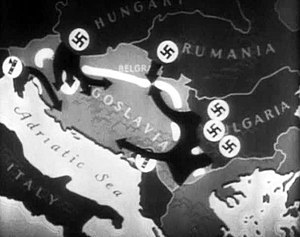
The Axis order of battle for the invasion of Yugoslavia was made up of the various operational formations of the German Wehrmacht and Waffen-SS, Italian Armed Forces and Hungarian Armed Forces that participated in the invasion of Yugoslavia during World War II, commencing on 6 April 1941. It involved the German 2nd Army, with elements of the 12th Army and a panzer group combined with overwhelming Luftwaffe (German Air Force) support. The eighteen German divisions included five panzer divisions, two motorised infantry divisions and two mountain divisions. The German force also included two well-equipped independent motorised regiments and was supported by over 800 aircraft. The Italian 2nd Army and 9th Army committed a total of 22 divisions, and the Royal Italian Air Force (Italian: Regia Aeronautica) had over 650 aircraft available to support the invasion. The Hungarian 3rd Army also participated, with support from the Royal Hungarian Air Force (Hungarian: Magyar Királyi Honvéd Légierő, MKHL).
The Axis ground forces had effectively surrounded the Kingdom of Yugoslavia before the invasion began. The German 2nd Army, consisting of one motorised, one mountain, and two infantry corps was concentrated in southwestern Hungary and southeastern Austria, poised to drive south and east. One motorised corps of the German 12th Army was assembled near Sofia, Bulgaria, along with one motorised corps of the First Panzer Group, and these formations were assigned the task of striking the strongest Yugoslav formations stationed along the eastern border of the country. A further motorised corps was deployed near Timișoara in western Romania, ready to thrust south into the Banat region. The Italian 2nd Army, consisting of one fast (Italian: celere) corps, one motorised corps and three infantry corps was assembled in northeastern Italy, with the task of driving southeast down the Dalmatian coast. The Italian 9th Army, comprising two corps and a sector defence command, was stationed in occupied northern Albania, and its stance was largely defensive. The Hungarian 3rd Army was concentrated along the Yugoslav border largely between the Danube and the Tisza, with the objective of seizing the Bačka and Baranja regions.
German, Italian and Hungarian air support was concentrated in Austria, Italy, southern Hungary, southern Romania, western Bulgaria and Albania. In total, over 1,500 Axis aircraft were available to support the invasion. Naval forces were limited to a few destroyers of the Royal Italian Navy (Italian: Regia Marina) operating in the Adriatic Sea.
© MMXXIII Rich X Search. We shall prevail. All rights reserved. Rich X Search
